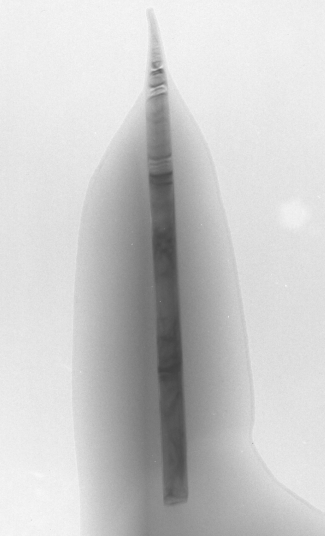Micro-analytical Study of the Optical Properties
of Rainbow and Sheen Obsidians
by
Chi Ma, George R. Rossman
Division of Geological and Planetary Sciences
California
Institute of Technology
Pasadena, CA 91125-2500 U.S.A
Jennifer Gresh, Gene C. Ulmer
Department of Geology
Temple University, Philadelphia, Pennsylvania 19122, U.S.A
Edward P. Vicenzi
Princeton Materials Institute
Princeton University, Princeton, Jew Jersey 08540, U.S.A.
Canadian Mineralogist 39, 57-71

Rainbow Obsidian
Abstract
Samples of Mexican obsidian that exhibit
either “sheen” or “rainbow” optical properties were examined with a
combination of EMP, SEM, TEM, as well as visible and IR spectroscopy.
Electron-microprobe analyses of the sheen matrix give (in wt.%): 76.2
SiO2, 0.2 TiO2, 11.6 Al2O3, 2.2 FeOTOT, 0.07 MgO, 0.1 CaO, 4.8 Na2O and 4.4 K2O.
The sheen is attributed to the presence of aligned flow-stretched
hollow vesicles in the gemological literature. SEM images show that
many of the flow-aligned lenticular areas are a second rhyolite glass
with, on average, 74.6 SiO2, 0.2 TiO2, 12.7 Al2O3, 2.1 FeOTOT, 0.1 MgO, 0.9 CaO, 5.6 Na2O and 4.6 K2O.
These two compositions do not overlap at the 2� level. Their inferred
indices of refraction differ by as much as 0.04, leading to optical
interference along the elliptical interfaces of the two glasses. Thus
we postulate that the sheen reflects differences in indices of
refraction (�n) between the matrix obsidian and the lower �of either
gas-filled or glass-filled vesicles. In our sample, the presence of the
second glass probably correlates with incorporation (and remelting?) of
fragments of an earlier rhyolitic ash or tuff. Two different types of
Mexican rainbow obsidian were studied. The first has layers of numerous
trachytically oriented rods (0.2–2 by 10–20 µ�m) of hedenbergite (Ca0.88Mg0.07Fe0.98Mn0.06Si2.01O6). The composition of the matrix is: 76.3 SiO2, 12.5 Al2O3, 1.7 FeOTOT, 0.01 MgO, 0.16 CaO, 4.4 Na2O and 4.6 K2O. The second type has trachytically aligned plagioclase (~An20), also rod-shaped (as small as 0.5 ×2.0 µm). The composition of the matrix is: 76.1 SiO2, 13.5 Al2O3, 0.7 FeOTOT, 0.09 MgO, 0.7 CaO, 3.75 Na2O and 4.85 K2O.
Multiple hypotheses are considered for the possible cause of the
rainbow effects: gas or fluid inclusions, a small component of
scattering centers, differential indices of refraction, Bragg
diffraction of visible light, and thin-film interference. Our data
support the last hypothesis.

A hedenbergite crystal in rainbow obsidian

